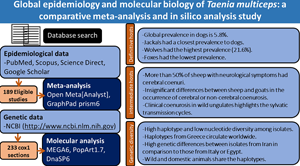Published online by Cambridge University Press: 12 August 2022

In the present study, all published data on the epidemiology and molecular characters of Taenia multiceps were systematically collected from relevant databases (e.g. PubMed, Scopus, National Center for Biotechnology Information), and combined in various statistical and genetic analyses as a contribution to a better understanding of the epidemiology of this ubiquitous taeniid worldwide. While 5.8% of the key hosts (dogs) from various countries had T. multiceps, grey wolves displayed the highest prevalence (21.6%) among the definitive hosts. Small ruminants are the main intermediate hosts and carry the coenuri in various locations, but most commonly in the central nervous system (CNS). Cerebral coenuri were confirmed in 53% of sheep exhibiting neurological symptoms, and infected animals often had only a single coenurus in the brain. Sheep had a higher prevalence (8.8%) of CNS coenuri than goats (5.8%); however, extra-CNS coenuri were detected more frequently in goats than in sheep. In either case, the difference between sheep and goats was statistically insignificant. Analysis of 233 partial cytochrome oxidase subunit I nucleotide sections for T. multiceps revealed high haplotype and low nucleotide diversities. Fifty-one haplotypes were detected circulating in 6 geographic populations. China, Iran and Turkey had 2 major haplotypes, whereas Italy and Egypt shared 3. Haplotypes from Greece circulate worldwide, and displayed similar gene flow values when compared with the other populations. There were no distinct patterns for haplotype distribution in relation to the infected hosts or coenuri locations. The existence of genetic variants in T. multiceps was highlighted, but needs further studies.
Equal contribution.